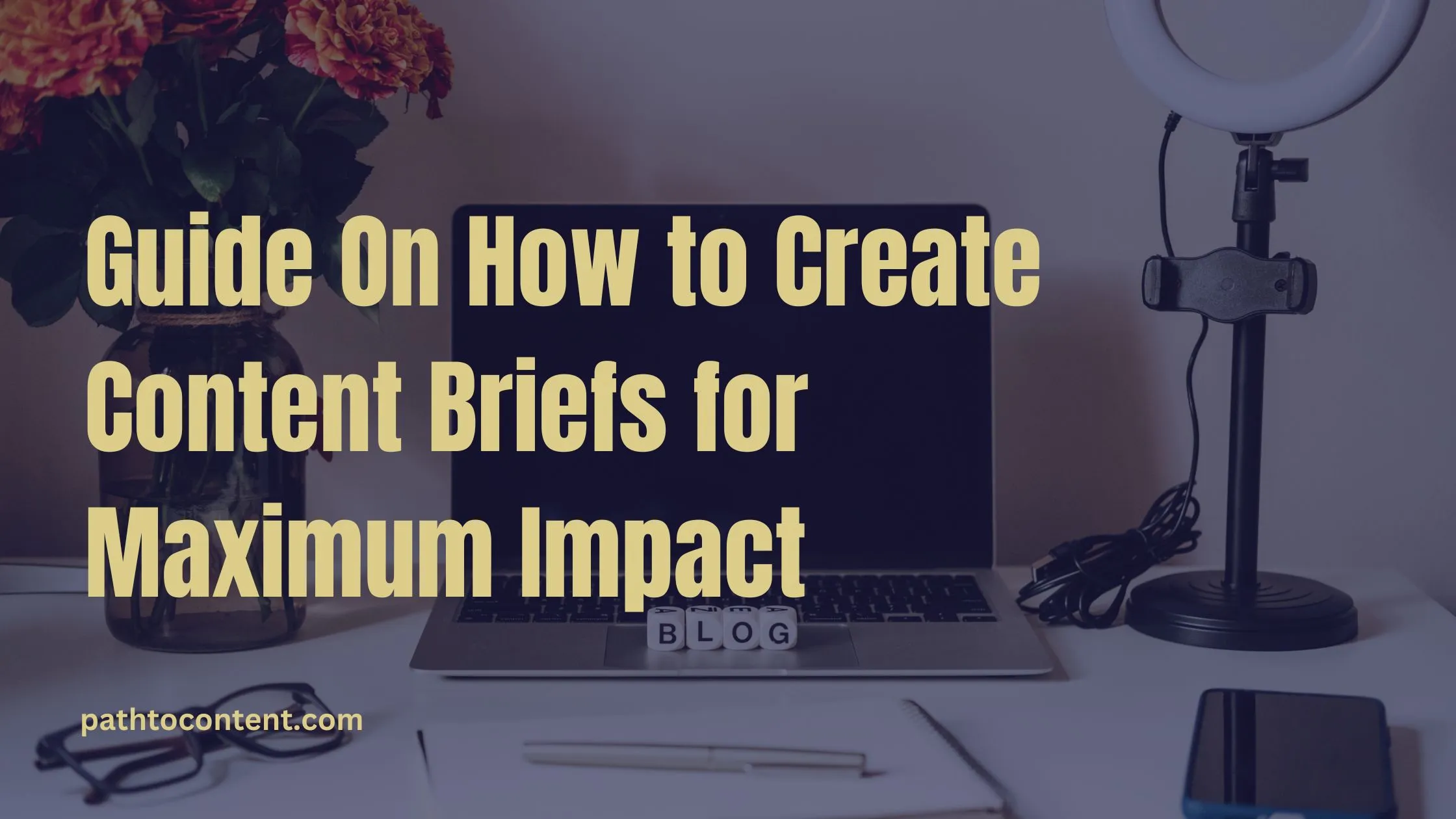Nothing makes my heart skip a beat more than when I’m given a content brief that’s nothing but the primary keyword.
No kidding, but getting an incomplete content brief is every writer’s worst nightmare.
Proper content briefs are literally saviors. There’s no need to scratch my head over what to research and no back-and-forths of multiple rewrites once you know how to create content briefs. (Heaven for writers, if you will.)
They’re equally important for businesses investing in blogs to succeed. Yes, I’m talking about you.
With the right brief, good writers become great and produce content that fulfills every purpose you have. The same becomes a distant dream with a half-baked content brief.
What’s the worst that can happen with such briefs? The writer loses precious hours writing a draft that gets rejected multiple times. The client loses resources on content that never gets them the desired results. What follows is only frustration.
To avoid it all, I like to create my brief and share it with my clients so we both know what to expect. I’m sharing my process for creating the perfect content brief for any content.
You’ll get:
- A list of questions to ask yourself before bringing in the writer
- A checklist for your content briefs
- A sample template
So, let’s make your content fulfill its purpose!
How To Create Content Briefs: A 7-Step Process
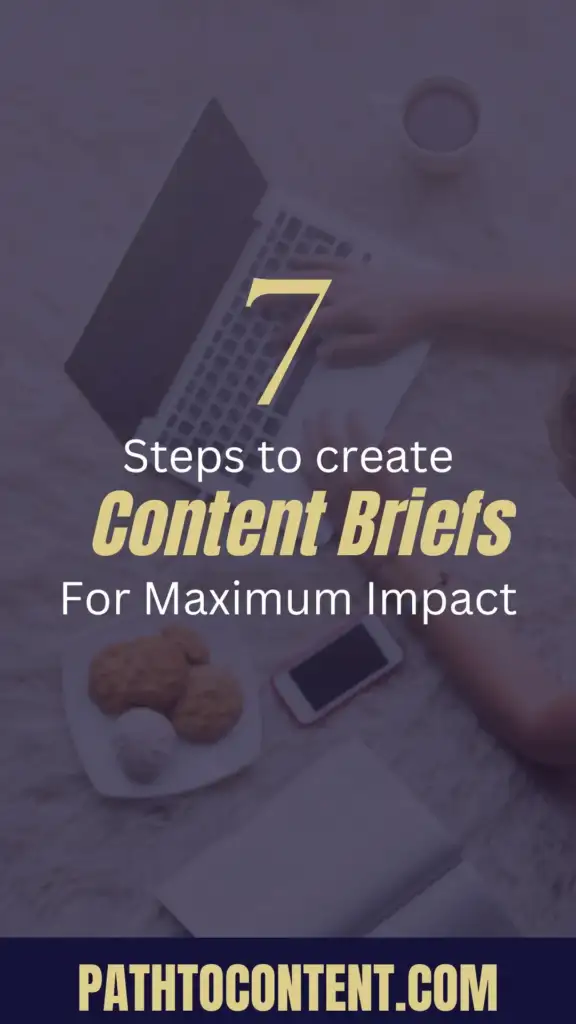
What Are You Writing? Start With The Topic
Usually, content briefs start with the primary keyword and end with a list of the top ten ranking articles for that keyword.
We need a lot more than that. For starters, what’s the topic you’re targeting?
There’s a difference between the keyword and the topic. Your topic gives you the central idea around which the content will revolve. It provides the framework for the discussion you conduct in your content. The keyword is a search query your target audience uses to research that topic.
We can decide what keyword to use based on the search volume, keyword difficulty, rankability, etc. But that all comes after you’ve zeroed down on the topic.
The first question to ask yourself: What topic do you want to address with the content piece?
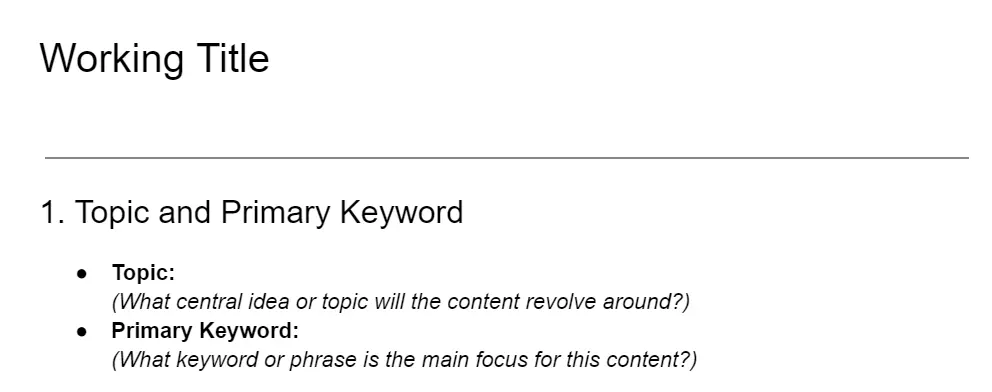
Why Are You Writing? What Goals Do You Want To Achieve?
Okay. The topic is sorted. Now comes the question of why that specific topic. In other words, what’s the purpose of the content piece?
When it comes to SEO content, usually, the only goal considered is ranking the post. But that’s not all. There are many other purposes for writing a piece of content:
- Driving traffic
- Building authority
- Engaging your audience
- Generating leads
- Supporting sales
- Fostering community
- Increasing brand awareness
You see? There’s so much more to it. You can’t really give justice to the content unless you know its goal.
Each purpose I mentioned needs a different approach, and the metrics to measure their success also vary.
The second question to yourself: Why are you writing this content piece? What do you want to achieve?
What is the primary objective of this content? Is it to drive traffic, generate leads, educate the audience, or something else? Not all blog posts have the same objective.
Why is this piece important? What happens if this content never gets published? Will it affect your goals in any way? If the answer significantly impacts, it indicates the content’s priority.
How will success be measured? Against what parameters will you measure the piece’s success or failure? Defining success metrics ensures the content delivers value, whether it’s the number of shares, comments, or conversions.
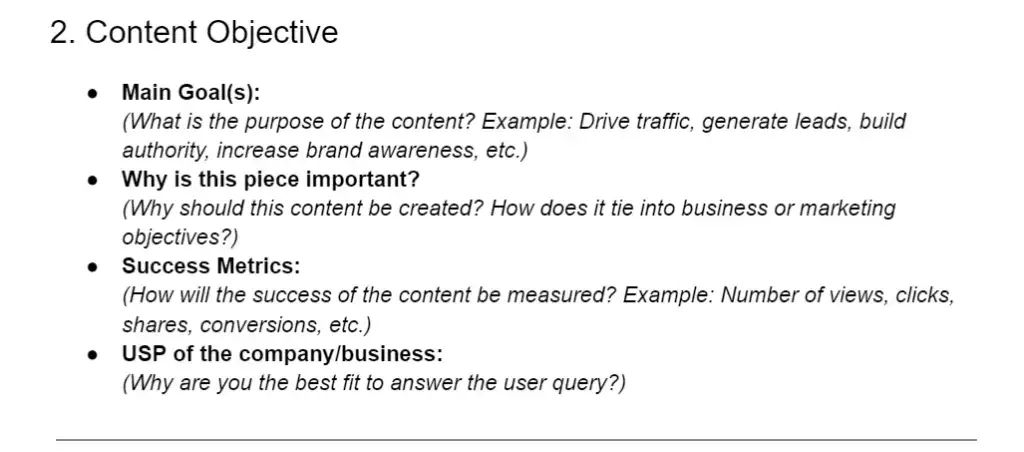
Who Are You Writing For?
Now that you know what you’re writing, you need to know who you’re writing for. I consider the target audience as the most critical part of creating content briefs.
You’re writing to solve a specific query your audience has. You miss out on a great opportunity to convert the audience into customers if you get the audience or their search intent wrong. The content is rendered useless. The information is rendered meaningless. You need to be extremely specific about who your target audience is.
Here’s what to consider when identifying the target audience:
Are there multiple target audiences? It’s common to have a single target audience per piece of content, but sometimes, there’s more than one. In that case, we have a primary and a secondary audience. The primary audience is the group intended to receive the content. The secondary audience is an additional group that might benefit from the content.
For example, a blog post titled “Best social media management tool” can have the primary audience as brands/businesses and the secondary audience as social media managers.
Or take this blog post as an example. I’m writing while taking the businesses creating content as my target audience. I could have also written with content writers as my target audience. Then, my writing approach would have changed, as would the expected results.
Still, I’ve kept the content writers as a secondary audience as they also get a lot from this article. But my main focus is businesses (or clients, for me).
The primary audience should receive the most direct and focused content, while the secondary audience can be addressed with supplementary information that still holds value for them.
What pain points does the content solve? Specify the target audience’s pain points and how the content will solve those problems. The pain points addressed and the solutions offered will differ depending on the content’s goal.
A TOFU blog post on a certain topic will only work as an introductory guide to make the audience aware of the problem, while a BOFU blog post will incorporate your product/service into the content as a solution.
What action do you want the audience to take?
I like to say actions are both tangible and intangible.
When you want the audience to click a CTA button, make a purchase, subscribe to a newsletter, download a freebie, etc., you make them take tangible actions.
But there’s another action where the audience makes a mental note. It could be about finding your content helpful and remembering your brand, finding your content authoritative, appreciating your unique perspective, recognizing the value you provide, feeling a connection with your messaging, or considering your brand as a future resource.
Now, that’s an action taken, and it’s visible through recurring visits or visitors converting into customers.
You need to know if you’re prompting a tangible or an intangible action through your content.
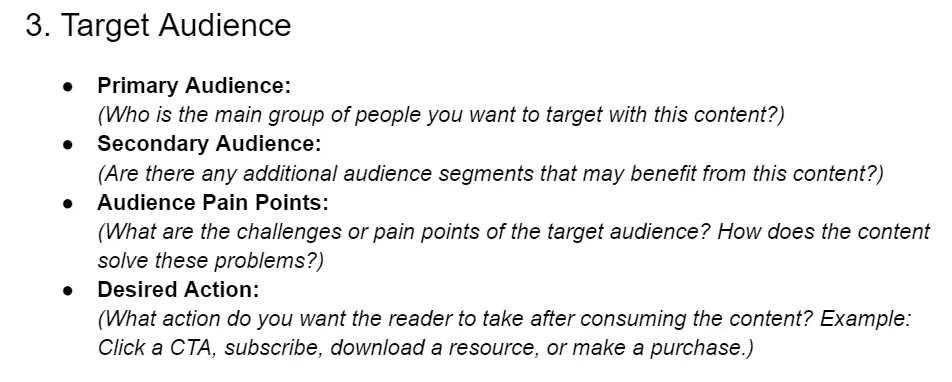
Competitor Research
After you’ve asked these defining questions, it’s time for you to rope in the writers to conduct research for the brief. It starts with competitor research.
Remeber the list of top ten ranking articles? You need them now.
You need competitor research mainly for two reasons:
- To see what they did right and double down on it
- To see what they got wrong or the gaps in their content and cash on it
There are many ways to approach competitor research. The common method is to plug your target keyword into tools such as Ahrefs or Semrush and analyze the competitor articles.
If you don’t use those tools, you can manually review the articles to analyze their content outlines, headers and topics covered, use of secondary and LSI keywords, and the depth of content they reached.
When reading competitor articles, put yourself in your audience’s shoes. Check if the articles solve all your questions when searching for the query. Try to piece each article together to see what they missed to answer.
The key to ranking articles is to nail the search intent and resolve the pain points. Use the time you use for competitor research mainly to analyze how the articles meet these criteria and how you can enhance the search results.
Do SERP analysis to understand the search intent. Map the pain points and research data to match the search intent.
Analyze competitors to find ways to improve their content. For example, for the blog post “Generating blog traffic for new bloggers,” the ranking articles added ways that were not feasible for newbies. This helped me curate a list highly specific to beginner bloggers so it matched the search intent.
Finally, by analyzing the SERP and reviewing the search intent and existing content, you can find the unique angle your content should have.
Think of a unique angle for your post. It’s something that’s not covered in the existing articles. It’s important because every article on the same topic constantly fights for the audience’s attention. You need something different to grab that attention.
This something unique can be interviews, case studies, or results generated by your clients. These can’t be replicated. It can also be a unique POV you add to the content not discussed elsewhere.
If finding a unique angle is difficult, you can make the topic more specific to a sub-niche.
For example: Many articles discuss online marketing. Make your article unique by writing about online marketing for small SaaS brands.
Uniqueness always stands out and gives you the required edge to get your blog ranked.
Scouting on Reddit, Quora, LinkedIn, Twitter, etc., to find queries your audience is asking is also a great way to add uniqueness to your content. These platforms have the potential to give you that unique angle because the discussions happen between real people with real problems.
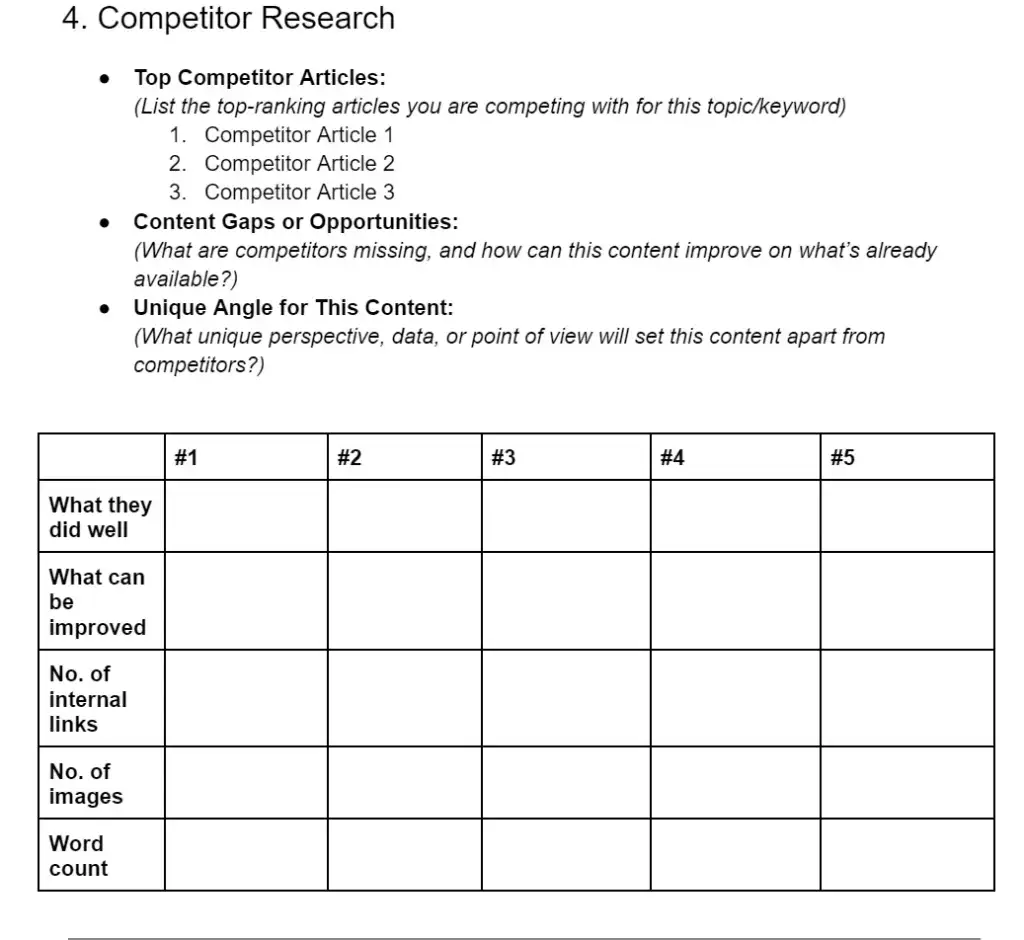
Content Research
Many times, content research isn’t considered part of the content brief, but it’s crucial. You need to know what to research, where to research, and how to incorporate it into the final content.
Having it all outlined in the brief makes your job easy.
The research process can vary with each content piece, but you can create a repository of research sources for each brief.
Collaborate with your writer or content team to create a list of:
- Internal sources, such as the sales team, customer feedback and testimonials, buying process and triggers, stakeholders, sales stories, product and research team, etc., hold a treasure trove of information about your overall market presence and the content we need to create.
- The external sources like social media platforms, industry groups, forums like Reddit, trends, podcasts, webinars you have attended, competitor profiles, etc., to find what’s working in the market and how the target audiences are reacting to the happenings in the industry.
- Additional resources can include newsletters by industry leaders, industry reports, and expert social media profiles, which you can refer to when adding relevant data to your content.
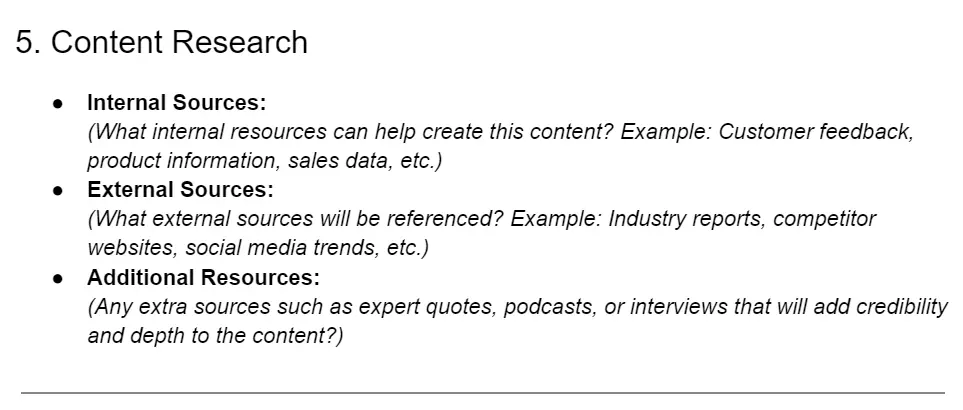
| Suggested reading: The 4 types of content research
On-page SEO
When I started out as a freelance writer, I thought all a content brief needed was details of on-page SEO. I was so wrong. On-page SEO is one of the last parts of content briefs.
After you’ve come to this stage, do fresh keyword research to find the secondary keywords and sub-topics you can include along with the primary keyword you’ve got from the client. This step also includes finalizing the meta title, meta description, etc.
People Also Ask is a great resource for finding questions people want instant answers to. These can become your subheaders in the post. If not, they can still become useful additions to the content. Related Searches is a further add-on to help you in this step. Don’t miss out on this golden opportunity to show your blog is better than the existing content.

| Suggested reading: SEO best practices for bloggers
Content Outline
Finally, you have all the information required to create the outline. Create an outline that answers the main query first. It’s time to get creative! Imagine you’re writing a novel, and your audience is the main lead.
Your main lead is struggling with a life-or-death situation, and your blog post is their savior. How would you structure it to make it the easiest journey for your main lead to come out alive? (i.e., understand and use the solution you provide.)
Arrange the points in a flow with a beginning, logical headers that naturally lead to another, and a conclusion.
Start with the most important part that the audience must know. Then, add supporting details explaining the main query to help the audience understand the main idea. Finally, add some background or additional information that would be nice to know.
If the topic is “how to improve E-E-A-T,” don’t start with “What is E-E-A-T.” The audience already knows that.
Ensure each significant section of the outline becomes a header.
For example, for a blog post on the topic “blog post outline,” the first header will be “The need for creating an outline,” followed by the subheaders for the actual steps.
Here, I sometimes refer to AI (ChatGPT, to be precise) for suggesting additional headers. AI can surprise you with unique headers you didn’t think of earlier.
The first answer by ChatGPT won’t always be perfect. After all, it’s a machine. It’ll work better as you go back and forth improving the prompts.
This way, you also ensure that the search intent is met with your outline. That is, the sequence in which the headers flow answers the search intent. It helps because many readers are skimmers who only go through the headers. If you align your content outline to answer their queries, you’ve also helped the skimmers along with dedicated readers.
Ensure the entire blog ties back to one message or takeaway for the readers. You don’t want the blog to intimidate the readers, lest they would repel it.
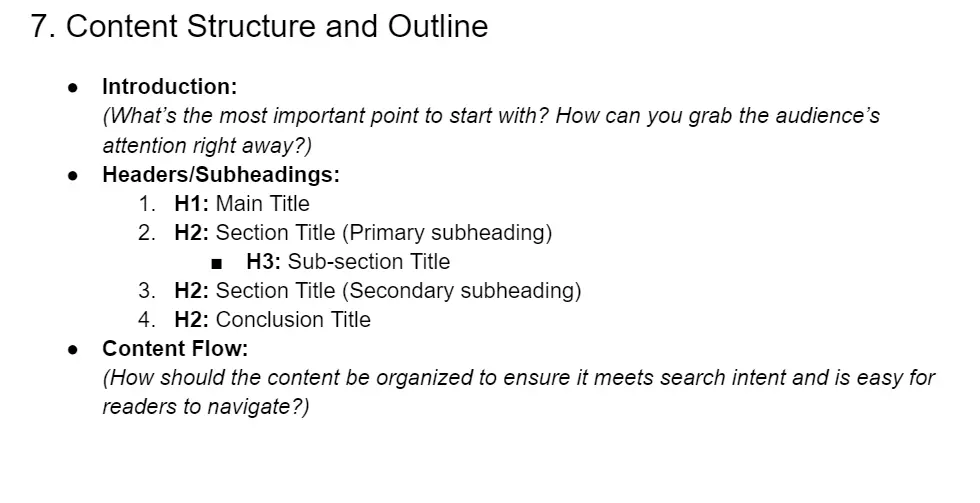
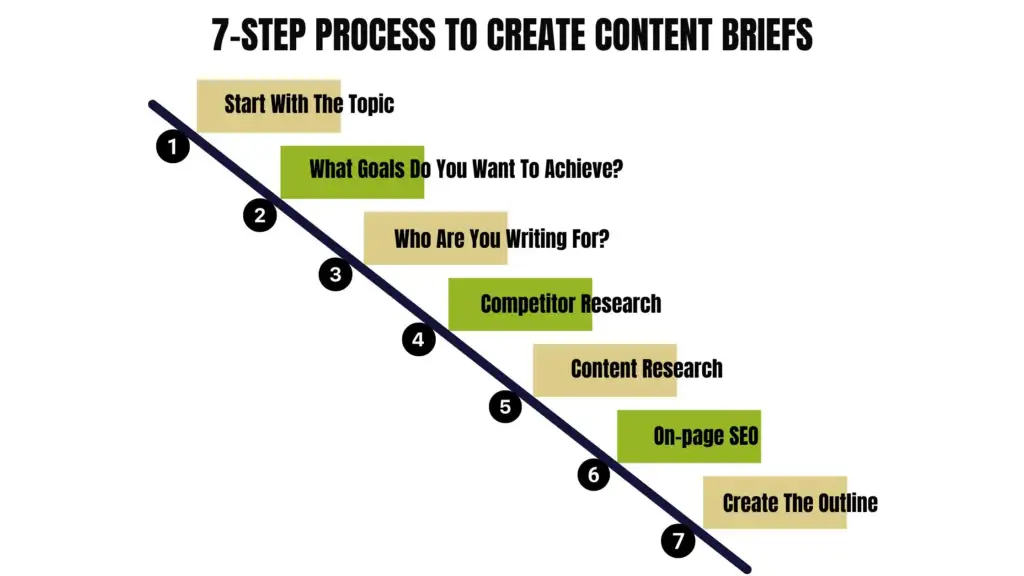
Some additional steps: Be more specific if you like it
The seven steps we discussed cover all essential aspects of a content brief. But if you want to make it more elaborate, you can add a section to specify the internal and external links, the places where you’ll add visuals, the sections where you’ll incorporate expert quotes, etc.
With internal linking, you show your topical authority and tell Google how to navigate through your website. Finding the correct places to link to other blogs and articles after the blog is written is quite messy. You don’t want to spend more time figuring that out. Make a note of the blogs you want to link (your own and other authoritative blogs) within the doc itself.
And creating an outline is the best time to list every blog you want to link. The ideas are fresh, and you’re not yet engrossed in blog writing. Here’s a screenshot of a comment I made to one of my blog post docs for internal linking.
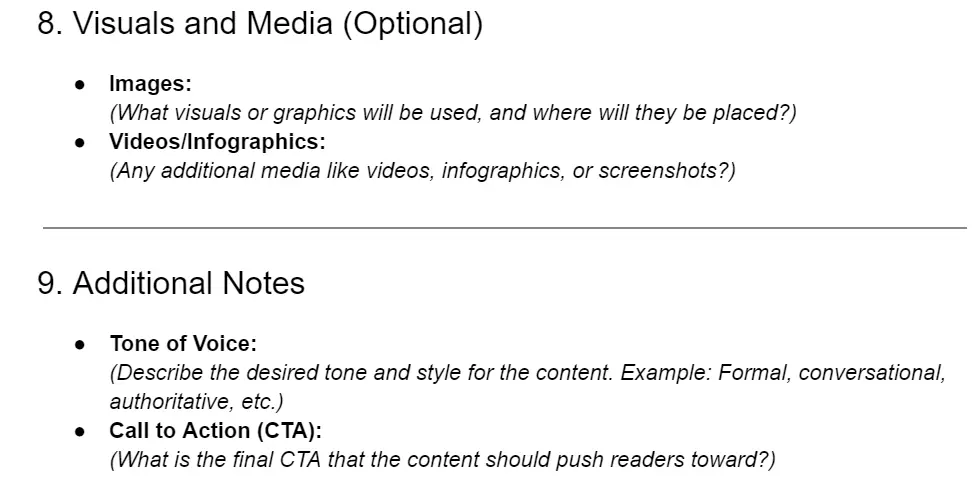
Creating Content Briefs: Conclusion
After you finish the content brief, you and your writer will have clarity on how the final draft will look.
Whether you have an in-house team or outsource writing, this will make it extremely easy for you and the writer to check if the final article matches its purpose, and you will reduce the edits to a minimum.
Complete Content Brief Template
Got more questions on creating content briefs? Want help strategizing your business blogs?
Book a 1:1 discovery call now!

